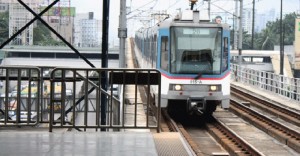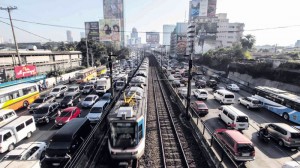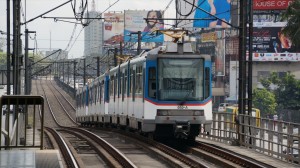By Lorenz S. Marasigan | Business Mirror | February 4, 2015 0 14
THE Metro Rail Transit (MRT) Line 3 must first undergo a total makeover before its maintenance contract could be deemed palatable to “serious” investors, the owner of the multibillion-peso train line said on Wednesday.
MRT Holdings II Inc. (MRTH-II) Chairman Robert L. Sobrepeña said the current state of the most congested train system in the Philippines could be described in one word: alarming. This, he said, means that the train system already poses certain risks to the riding public.
“The rehabilitation and proper maintenance of the system cannot wait. We must take any and all steps needed to restore the system to make it safe and reliable for the riding public,” he said.
Rehabilitation, Sobrepeña said, would ensure the integrity of the train line that connects the northern and southern corridors of Metro Manila.
“Fast-track rehab is key and foremost. It must be done to assure safety of the riding public and to restore the MRT 3. Once the fast-track rehab is done by a credible company with proven track record and financial capacity, then the MRT 3 can operate at its original capacity again, and the long lines at stations will be greatly minimized,” he said.
This, Sobrepeña said, would pave the way for a successful procurement of a reputable maintenance provider for the train line. The two auctions for the P2.38-billion MRT maintenance contract were snubbed by private railway operators due to the line’s dilapidated state.
During the first tender, Busan Transport Corp., Mosan-Inekon Phils. Ltd. Co., SMRT International Pte. Ltd., Miescorrail Inc. and D.M.
Consunji Inc. bought documents related to the bidding; but all decided to not make an offer. The second round of bidding, however, saw no party buying bid documents.
The multibillion-peso upkeep deal involves a three-year concession period and sweetened terms.
Due to the failed bidding, the current upkeep provider, APT Global Inc., will continue maintaining the line, along with the shadowing team deployed by the transport agency.
“To attract bidders, the DOTC [Department of Transportation and Communications] even relaxed the terms of the second bidding. This would be a step in the wrong direction, as what is needed is the stricter implementation of safety requirements and measures,” he said.
“Noteworthy is the fact that the private owners were again not consulted for the terms of reference for the second bidding, again in violation of the build-lease-transfer agreement,” Sobrepeña added.
The businessman also called on the government to base the upgrades on the recommendations of the experts from Hong Kong’s MTR Corp. Ltd.
“The report showed the alarming state of the MRT 3 system that we have been warning the public about,” he said.
The report from the rail experts from Hong Kong showed that the overhead mass-transit system had major flaws in rails, emphasizing on the need to replace “unsafe tracks” that was backed by a four-fold increase in broken rails over a period of three years.
“The present maintenance provider has admitted that it has no spare rails. Clearly, rails must be bought. The system is already under an emergency situation. A worldwide search must be made to find a ready and steady supply of rails from a reputable manufacturer,” he said.
“In addition, the system must also be restored back to having all 73 cars operable to reduce not only the long queues but safety concerns as well,” Sobrepeña added.
Not all of the train cars are being deployed for daily operations, some were readied for emergency situations.
Thankfully, the government is rolling out a P9.7-billion venture to overhaul the line. The complete makeover is expected to be done within the term of President Aquino.
It includes the procurement of additional train coaches, train general overhauling, ancillary systems upgrade, platform edge doorstep, signaling-system upgrade, rail steel replacement, communications system upgrade, traction motors re-placement, and the improvement of the overhead catenary system.
The rehab venture also includes: security fence and noise barrier, consulting services, upgrade of conveyance facilities, a footbridge for the North Avenue Station, weather protection cladding, Internet connection, passenger information system, and passenger hand straps.
A number of these, including the procurement of rails, have been awarded.
Separately, local flagship of the Hong Kong-based First Pacific Co. Ltd. is proposing to shoulder the upgrade costs of the train system and free the government from paying billions of pesos in equity rental payments.
Metro Pacific Investments Corp. President Jose Ma. K. Lim said his group will soon submit its $524-million proposal to the DOTC, which has already rejected the then $565-million offer.
The lower budget for the offer, Metro Pacific Business Development Officer John B. Echauz explained, stemmed from the removal of the automated fare-collection system and another component from the proposal.
The unified-ticketing system project was auctioned off by the transportation agency in 2013, and was awarded to the consortium between Metro Pacific and Ayala Corp. in 2014.
The total $524 million also included the $30-million working capital and the $229-million budget for the settlement of the government’s equity-rental payment.
The group of businessman Manuel V. Pangilinan earlier entered into a partnership agreement with the corporate owner of the MRT, a move that would have allowed the firm to invest roughly $600 million to improve the services of the train system.
The venture would effectively expand the capacity of the railway system by adding more coaches to each train, allowing it to carry more cars at faster intervals. The multimillion-dollar expansion plan would double the capacity of the line to 700,000 passengers a day from the current 350,000 passengers daily.
It was submitted in 2011, but the transportation agency’s chief back then rejected the proposal.
The government, on the other hand, intends to buyout the corporate owner of the line, the MRT Corp., which is controlled by MRTH-II.
The government aims to completely takeover the line by the time President Aquino steps down from office in 2016. But recent delays, including the “tying up of loose ends,” are forcing the government to double its efforts to effect the buyout.
One of the requirements to execute the takeover is for the government to strike up a compromise deal with the private owner of the train line.
This would effectively end the ongoing arbitration case in Singapore that was lodged against the government in 2008 due to its failure, as the operator of the line, to pay billions of equity rentals payment to the owner of the rail system.
Should the buyout be completed in 2016, the transportation agency may then bid out the operations and maintenance contract of the line, thereby tapping private-sector efficiency and customer service orientation for operational needs, while retaining regulatory functions for passenger protection with government.
Since 2004, the train system has been operating at overcapacity. Currently, the line serves nearly 550,000 passengers per day and even reached, at one point this year, the 650,000-daily passenger mark. It has a rated capacity of 350,000 daily passengers.
Lorenz S. Marasigan





